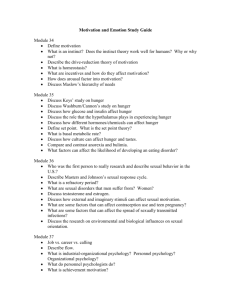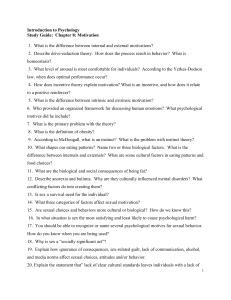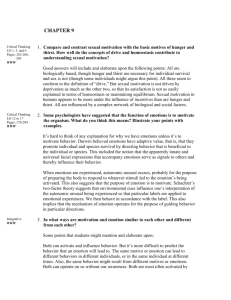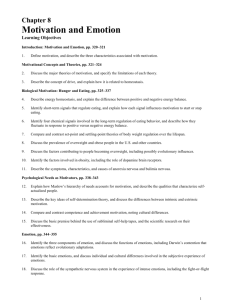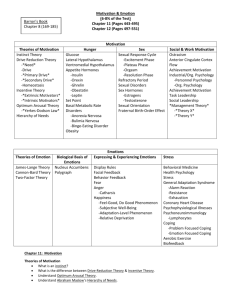Chapter 10 (Motivation and Emotion).
advertisement
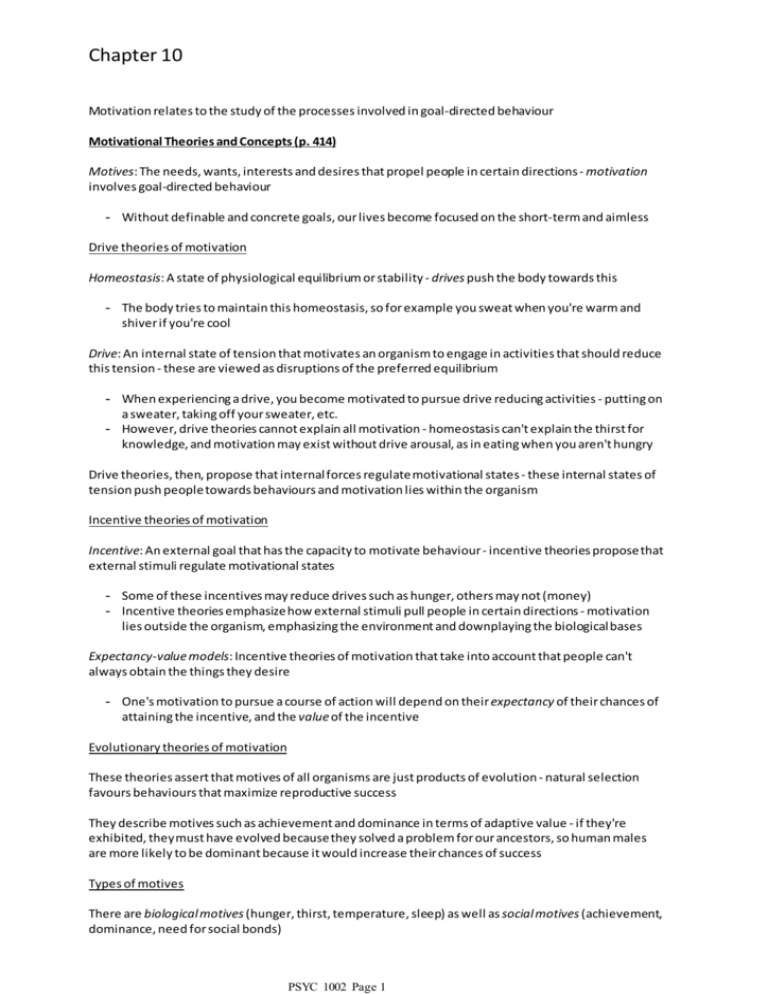
Chapter 10 Motivation relates to the study of the processes involved in goal-directed behaviour Motivational Theories and Concepts (p. 414) Motives: The needs, wants, interests and desires that propel people in certain directions - motivation involves goal-directed behaviour - Without definable and concrete goals, our lives become focused on the short-term and aimless Drive theories of motivation Homeostasis: A state of physiological equilibrium or stability - drives push the body towards this - The body tries to maintain this homeostasis, so for example you sweat when you're warm and shiver if you're cool Drive: An internal state of tension that motivates an organism to engage in activities that should reduce this tension - these are viewed as disruptions of the preferred equilibrium - When experiencing a drive, you become motivated to pursue drive reducing activities - putting on a sweater, taking off your sweater, etc. - However, drive theories cannot explain all motivation - homeostasis can't explain the thirst for knowledge, and motivation may exist without drive arousal, as in eating when you aren't hungry Drive theories, then, propose that internal forces regulate motivational states - these internal states of tension push people towards behaviours and motivation lies within the organism Incentive theories of motivation Incentive: An external goal that has the capacity to motivate behaviour - incentive theories propose that external stimuli regulate motivational states - Some of these incentives may reduce drives such as hunger, others may not (money) - Incentive theories emphasize how external stimuli pull people in certain directions - motivation lies outside the organism, emphasizing the environment and downplaying the biological bases Expectancy-value models: Incentive theories of motivation that take into account that people can't always obtain the things they desire - One's motivation to pursue a course of action will depend on their expectancy of their chances of attaining the incentive, and the value of the incentive Evolutionary theories of motivation These theories assert that motives of all organisms are just products of evolution - natural selection favours behaviours that maximize reproductive success They describe motives such as achievement and dominance in terms of adaptive value - if they're exhibited, they must have evolved because they solved a problem for our ancestors, so human males are more likely to be dominant because it would increase their chances of success Types of motives There are biological motives (hunger, thirst, temperature, sleep) as well as social motives (achievement, dominance, need for social bonds) PSYC 1002 Page 1 People all share the same biological motives, as they're essential for survival, but social motives are learned and we can acquire an unlimited number of social motives through learning and socialization The Motivation of Hunger and Eating (p. 416) Biological factors in hunger regulation Older theories of hunger identified the hypothalamus as the control point for hunger - the lateral hypothalamus could be lesioned to remove the drive for hunger and the ventromedial nucleus of the hypothalamus could be lesioned to induce excessive eating and weight gain - However, these aren't the only contributors to hunger, and the paraventricular nucleus has been shown to play a significant role in the modulation of hunger Modern theories focus more on neural circuits passing through the brain rather than specific anatomical centres - ghrelin plays a large role in this, with elevated ghrelin levels being associated with increased food intake Glucose: A simple sugar that is an important source of energy - much of the food taken into the body is converted into glucose Glucostatic theories of hunger propose that fluctuations in blood glucose are monitored in the brain by glucostats - neurons sensitive to glucose in the surrounding fluid - However, glucose levels don't fluctuate much or very quickly, but they do contribute to the modulation of eating Nerves in the stomach send signals to the brain to inhibit further eating when the stomach is full Insulin is a hormone secreted by the pancreas used to extract glucose from the blood - increased insulin is associated with increased hunger, and the mere sight of food can stimulate the secretion of insulin - Insulin levels also appear to be sensitive to fluctuations in the body's fat stores Leptin is a hormone produced by fat cells throughout the body that is released into the bloodstream, with higher levels of fat generating higher levels of leptin - leptin eventually passes through the hypothalamus with information about the body's fat stores - When leptin levels are high, the propensity to feel hungry diminishes Environmental factors in hunger regulation Some theories emphasize the incentive value of food and eating - the availability and palatability (taste) of food are key factors in regulating hunger, with the presence of tasty food leading people to eat when already full - Sensory-specific satiety: As you eat a specific food, its incentive value decreases - if only a few foods are available, the appeal may decline quickly, while many foods can lead to overeating Eating is also a social action, and social cues based on the behaviour of others may influence food intake based on social norms of the situation Preferences for food are acquired through learning - this is why some people like pizza and others like calves' brains Humans do have innate preferences for sweet tastes and high-fat foods - on the other hand, youngsters can be conditioned to like certain foods Eating habits can also be influenced by observational learning from their parents PSYC 1002 Page 2 - Eating habits can also be influenced by observational learning from their parents Stress can also lead to increased eating, especially for chronic dieters - for some, it may be that they expect treats to make them feel better, but this strategy doesn't seem to have any real effects Eating and weight: Obesity Obesity: The condition of being overweight, generally based on the body mass index - an individual's weight (in kilograms) divided by height (in meters), squared - A BMI over 30 is considered obese, while 25-29.9 is obese Having obese parents increases the odds of obesity in children, and once people are overweight they are more likely than not to put on more weight - Research suggests that there is a genetic basis for how easily people gain weight - adopted children more closely resemble their biological parents in weight, and identical twins reared apart are more similar in BMI than fraternal twins reared together Over the course of history, most animals and humans have had fierce competition for limited food resources and so we evolved a tendency to consume more food than necessary whenever possible extra calories are then stored in the body as fat In today's industrialized societies, most people have too much food rather than too little, and the tendency to overeat has led to chronically excessive food intake - Because of genetic factors, metabolism, and other factors only some people become overweight Also common in industrialized societies is taking in more energy from food than is consumed in physical activities and by metabolism - increased food intake has been paralleled by declining physical activity Eating and weight: Trying to lose weight People who lose weight on a diet often gain back all of the weight they lose - people who have to work to gain weight also have trouble keeping it on Set-point theory: Proposes that the body monitors the fat-cell levels to keep them (and thus weight) fairly stable - when fat stores slip below a crucial set point, the body supposedly compensates for this change leading to increased hunger and decreased metabolism - Proposes that an obese person's body will actively defend an excessive weight Settling-point theory: Proposes that weight tends to drift around the level at which the constellation of factors that determine food consumption and energy expenditure achieves an equilibrium - weight tends to remain fairly stable as long as there are no durable changes in any factors that influence it - This theory attributes weight to more general processes - Suggests that if an obese person makes long-term changes in eating or exercise, that person's settling point will drift downward Chronic dieters, meanwhile, are restrained eaters - they consciously work overtime to control their eating impulses and feel guilty when they fail - To lose weight, they go hungry much of the time, but are constantly thinking about food - when their cognitive control is disrupted, , they become disinhibited and eat to excess - They assume that they're either on a diet or out of control, and often give up as soon as they feel they've cheated on their diet - Restrained eaters also seem to be particularly sensitive to media portrayal of idealized body types - after viewing such idealized images, restrained eaters tended to report thinner ideal body size than unrestrained eaters, and disinhibited their restraint to a greater extent PSYC 1002 Page 3 size than unrestrained eaters, and disinhibited their restraint to a greater extent Eating disorders Anorexia nervosa: Mostly affects young women, who starve themselves - sometimes to death Bulimia nervosa: Again affecting mostly young women, who alternate between binge eating and purging Eating disorders are more prevalent in women than men Activity anorexia: A combination of severe dieting and excessive exercise that elicits a biochemical process resulting in starvation and eventually death - the excessive physical activity actually decreases appetite and is central to the nature of anorexia Sexual Motivation and Behaviour (p. 425) Sex is essential for the survival of a species, but not the survival of an individual - so unlike hunger, it's driven less by deprivation Hormones secreted by the ovaries and testes can influence sexual motivation - estrogens in women, androgens in men - both genders have some of each, but the balances are different In man animals, females are sexually receptive only prior to ovulation when their hormone levels are higher Primates, however, are less affected by hormones - but extreme variations in hormone levels can affect sexual desire - Androgen levels seem to have an effect on both genders - Sexual activity can also increase testosterone levels, so the relationship may not be casual Evolutionary analyses of human sexual behaviour Parental investment theory: A species' mating patterns depend on what each sex has to invest in terms of time, energy, and survival risk to produce and nurture offspring - The sex that makes the smaller investment will compete for mating opportunities with the sex that makes the larger investment, and the sex with the larger investment will be more discriminating in selecting its partners - Human males are "required" to invest little in the production of offspring, so their reproductive potential is maximized by mating with as many females as possible - Meanwhile, human females have to invest nine months in pregnancy, then devote several years to nourishing offspring - they have little incentive for mating with many males, and would best be served by picking the best male to mate with - According to this theory, men will show more interest in sexual activity, have greater desire for variety in sexual partners, and be more willing to engage in uncommitted sex Gender differences Men think about sex more frequently, initiate sex more frequently, and are more interested in sex for its own sake - they're more motivated to pursue sex with a variety of partners, and more likely to have sex with someone they had known for only a brief period Men have also been shown to have more frequent and more intense sexual desires - however, these sexual disparities may all be exaggerated by reliance of subjects' self-reports due to the double standard regarding sexuality There are gender differences in mate preferences as well, with men placing more emphasis on a youthful partner (better for reproduction) while women place more importance on material resources and willingness to invest - these aren't conscious strategies, but rather subconscious preferences hardwired into the brain by evolution PSYC 1002 Page 4 hardwired into the brain by evolution Alternatively, these differences may be learned through culture, and enforced by a variety of socioeconomic factors over generations Sexual orientation Sexual orientation: A person's preference for emotional and sexual relationships with individuals of the same sex, the other sex, or either sex - heterosexuals seek relationships with the other sex, bisexuals with either, and homosexuals with members of the same sex However, sexual preference is more of a continuum - people who view themselves as heterosexuals have often had homosexual experiences - Homosexuality and heterosexuality should instead be viewed as endpoints on the continuum No one really knows how common homosexuality is, because of extreme prejudice towards it Environmental theories of sexual orientation Freudian theorists argue that a male is likely to become gay when raised by a weak, detached, ineffectual father who is a poor heterosexual role model and an overprotective, close-binding mother with whom the boy identifies Behavioural theories have argued that homosexuality is a learned preference acquired when same-sex stimuli have been paired with sexual arousal Extensive research, however, has failed to support these theories - however, extremely feminine behaviour in boys and extremely masculine behaviour in girls has been shown to predict homosexuality, and most gay men and women report being able to trace their homosexuality back to their childhood Biological theories of sexual orientation Twin studies on homosexual twins has shown a strong genetic predisposition for homosexuality: 52% of gay men had gay twins, while only 22% of their fraternal twins were gay, and 11% of their adoptive brothers - similar results have been found in women - However, more recent studies have found smaller estimates Hormonal secretions during critical periods of prenatal development may shape sexual development, organizing the brain in a lasting manner that influences subsequent sexual orientation - Higher rates of homosexuality have been found in women exposed to high levels of androgens in the womb Women seem to be more flexible in their sexuality, with more influence from sociocultural factors and earlier emergence compared to men Human sexual response cycle Excitement phase: The level of physical arousal escalates quickly, with muscle tension, respiration rate, heart rate, and blood pressure increasing quickly Plateau phase: Physiological arousal continues to build, but at a much slower pace Orgasm phase: When sexual arousal reaches its peak intensity and is discharged in a series of muscular contractions - men reach orgasm more reliably, which may be the result of evolution, culture, or sexual scripts - Lesbian women reach orgasm more reliably, supporting the theory that it's a matter of sexual scripts or culture PSYC 1002 Page 5 scripts or culture Resolution phase: Physiological changes subside, followed by a refractory period for men - a period where men are unresponsive to further stimulation which grows longer with age Achievement: In Search of Excellence (p. 437) Achievement motive: The need to master difficult challenges, to outperform others, and to met high standards of excellence The need for achievement is a fairly stable aspect of personality, and the Thematic Apperception Test (TAT) was designed to measure it - The TAT is a projective test, where the subjects respond to vague, ambiguous stimuli in ways that may reveal their motives and traits - However, some people believe the TAT is outdated and uses older standards not relevant to today's society The people who score high in the need for achievement tend to work harder, and more persistently, than people low on the need for achievement - they also handle negative feedback more effectively, are more future oriented, and more likely to delay gratification for long-term goals High achievement motivation correlates positively with measures of career success and upward social mobility Situational factors can also influence the drive for achievement, with a few factors being singled out: - The strength of one's motivation to achieve success, and likelihood to approach difficult tasks - a stable aspect of personality - One's estimate of the probability of success - varies from task to ask - The incentive value of success - depends on the rewards for success - One's fear of failure and likelihood to avoid difficult tasks - a stable aspect of personality - The negative incentive value of failure - depends on the risk of the failing at the task As tasks get easier, success becomes less satisfying - as they become harder, success becomes more satisfying, but at the cost of the probability to succeed Subjects high in the need for achievement tend to select tasks of intermediate difficulty - these tasks offer the best incentive value overall John Atkinson has proposed a theory of achievement motivation centred around the desire to approach and avoid challenge The influence of fear on motivation illustrates how motivation and emotions are intertwined - anger can cause motivation, but it can also be caused by motivation The Elements of Emotional Experience (p. 440) Emotion: Has three components - a subjective conscious experience (cognitive component), bodily arousal (physiological component) and characteristic overt expressions (behavioural component) Cognitive component Psychologists generally rely on subjects' verbal reports when studying this - people's cognitive appraisals of events in their lives are key determinants of the emotions they experience Emotion has an evaluative aspect, where we characterize our emotions as pleasant or unpleasant though some emotions are a mix of both Research has mostly focused on negative emotions, but there seem to be fewer positive emotions and they seem to be harder to differentiate - negative emotions also seem to have more powerful effect PSYC 1002 Page 6 The events that trigger specific emotions are fairly similar cross-culturally - people also tend to evaluate situations the same way Physiological component Emotions are accompanied by visceral arousal - this mostly occurs through the autonomic nervous system and activation of the fight-or-flight response Galvanic skin response (GSR) - An increase in the electrical conductivity of the skin that occurs when sweat glands increase their activity - this is a convenient and sensitive measure of autonomic arousal and emotions Polygraph (lie detector) - A device that records autonomic fluctuations while a subject is questioned, such as their GSR - sometimes used when interrogating suspects for a crime - The assumption is that when subjects lie, they experience anxiety, producing noticeable changes in physiology - The examiner first asks a number of nonthreatening questions to establish the subject's baseline - Then they ask the critical questions related to the crime and observe if their autonomic arousal changes - However… people who are telling the truth may become nervous during the test, and pathological liars can lie without experiencing any anxiety - so these tests aren't very reliable Affective neuroscience: The examination of the neurobiology of emotions - the neural bases of emotion are widely distributed throughout the brain - The limbic system, including the hypothalamus and amygdala, have long been viewed as the seat of emotion - but many other structures in the brain contribute - The amygdala does, however, play a key role in the acquisition of conditioned fears - The prefrontal cortex contributes to voluntary control of emotions, as well as emotions associated with the pursuit of goals Behavioural component Emotions are expressed through body language - nonverbal behaviour that seems fairly constant across cultures From facial cues in photographs, people generally identify six basic emotions: happiness, sadness, anger, fear, surprise, and disgust - other emotions are often identified, but less reliably than the basic six - This identification seems to occur quickly and automatically Facial feedback hypothesis: Our facial muscles send signals to our brains, and these signals help the brain recognize the emotions we are experiencing - Studies show that if subjects are instructed to mimic facial expressions associated with certain emotions, they tend to report that they actually experience those emotions to some degree - Facial expressions seem to be largely innate - even people who have been blind since birth smile and frown There's considerable cross-cultural agreement in the identification of the six basic emotions - This might have something to do with exposure to Western media, but even remote tribes with no Western contact identify the same basic emotions Cross-cultural differences Japanese culture encourages socially engaging emotions (friendly feelings, sympathy, guilt) more than North American culture PSYC 1002 Page 7 North American culture Meanwhile, North American culture encourages socially disengaging emotions (pride, anger) more than Japanese culture While natural facial expressions seem to transcend culture, people often learn to control and modify these expressions according to their cultural rules Display rules: Norms that regulate the appropriate expression of emotions - when, how, and to whom people can show various emotions, which varies from culture to culture Theories of Emotion (p. 446) James-Lange Theory William James proposed a theory of emotion in 1884, around the same time as Carl Lange, proposing that the conscious experience of emotion results from one's perception of autonomic arousal - According to this theory, the perception of visceral arousal (fight or flight response) leads to the conscious experience of fear - you're fearful because your pulse is racing - This emphasizes the physiological determinants of emotion - according to this view, different patterns of autonomic activation lead to the experience of different emotions - People supposedly distinguish emotions such as fear, joy, and anger on the basis of the configuration of physical reactions they experience Cannon-Bard Theory Walter Cannon argued that: - Physiological arousal can occur without the experience of emotion - Visceral changes are also too slow to precede conscious experience of emotion - People experiencing different emotions show almost identical patterns of autonomic arousal Philip Bard elaborated on his theory, creating the Cannon-Bard theory of emotion In their theory, emotion occurs when the thalamus sends signals simultaneously to the cortex (conscious experience) and autonomic nervous system (visceral arousal) Schacter's Two-Factor Theory Stanley Schacter proposed that people look at situational cues to differentiate among alternative emotions, and that emotion depends on two factors: autonomic arousal and cognitive interpretation When you experience visceral arousal, you search your environment for an explanation and label the emotion appropriately - rather than internal cues such as patterns of arousal However, emotions aren't completely moulded by the immediate context, which is one limitation to this theory Evolutionary Theories of Emotion Darwinian theories believe that emotions developed because of their adaptive values - fear would help the organism to avoid danger and aid in survival, for example Emotions are considered innate reactions to certain stimuli - immediately recognizable under most situations without much thought, even by primitive organisms They also assert that emotion evolved before thought, and that thought plays only a small role in emotion - assumes that emotions originate in subcortical brain structures that evolved before the higher brain areas PSYC 1002 Page 8 brain areas Another part of evolutionary theories is that there are a limited number of emotions with specific adaptive values - generally, theorists identify eight to ten primary emotions and other emotions are merely a blend of these primary emotions or a variation in intensity PSYC 1002 Page 9



